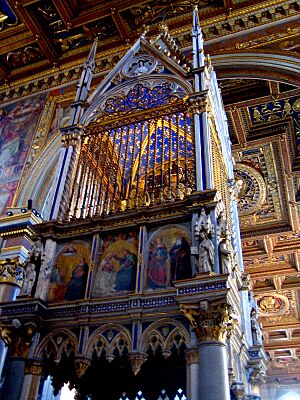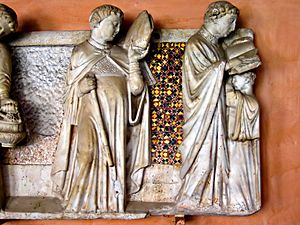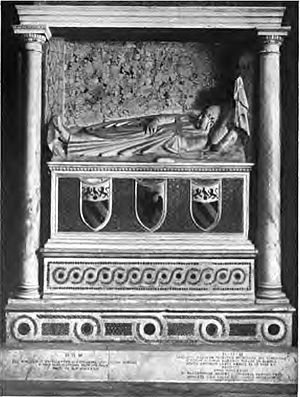Arnolfo di Cambio facts for kids
Quick facts for kids
Arnolfo di Cambio
|
|
|---|---|
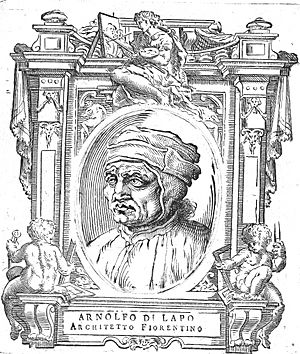
Arnolfo di Cambio by Vasari
|
|
| Born |
Arnolfo di Lapo
1232/1240 |
| Died | 8 March 1302/1310 |
| Nationality | Italian |
| Occupation | Architect and sculptor |
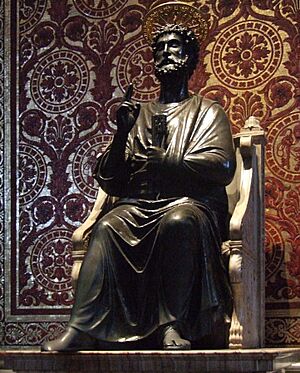
Arnolfo di Cambio (around 1240 – between 1300 and 1310) was a very important Italian architect and sculptor. He helped design the famous Florence Cathedral and the sixth city wall around Florence. One of his most important sculptures that still exists today is the tomb of Cardinal de Braye in S. Domenico, Orvieto.
Contents
Biography
Arnolfo was born in Colle Val d'Elsa, a town in Tuscany, Italy.
He started his career as the main helper to Nicola Pisano, a famous sculptor. They worked together on the beautiful marble Siena Cathedral Pulpit for the Duomo in Siena Cathedral from 1265 to 1268. Soon after, Arnolfo began creating his own sculptures, especially important tomb monuments.
Around 1266–1267, he worked in Rome for King Charles I of Anjou. He created a famous statue of the king, which is now in the Campidoglio museum. Around 1282, he finished the monument for Cardinal Guillaume de Braye in the church of San Domenico in Orvieto. This monument included a statue of the Madonna (Mary) seated on a throne, known as a Maestà. For this, he was inspired by an old Roman statue of a goddess called Abundantia. The crown and jewels on the Madonna statue look like ancient Roman designs.
In Rome, Arnolfo saw a special type of art called Cosmatesque art. This style used colorful patterns made from small pieces of stone and glass. You can see its influence in his work at the Basilica of Saint Paul Outside the Walls and the church Santa Cecilia in Trastevere, where he worked in 1285 and 1293. During this time, he also worked on a presepio (a scene of Jesus's birth) for Santa Maria Maggiore. He also contributed to Santa Maria in Aracoeli, the monument for Pope Boniface VIII (around 1300), and the bronze statue of St. Peter in St. Peter's Basilica.
From 1294 to 1295, Arnolfo mainly worked as an architect in Florence. According to his biographer, Giorgio Vasari, Arnolfo was in charge of building the city's main cathedral. He also created the statues that once decorated the lower part of the cathedral's front, which was later changed in 1589. The statues that survived are now in the Museum of the Cathedral. While some people think he designed the Church of Santa Croce, this is not certain. Vasari also believed Arnolfo planned the layout of the new city of San Giovanni Valdarno.
Arnolfo's grand and impressive work greatly shaped the look of Florence. His tomb monuments became a model for other artists creating Gothic funeral art.
Selected works
Architecture
- Santa Maria del Fiore, Florence, started in 1296. Arnolfo's original design was later expanded and finished by other architects over the next two centuries.
- Palazzo Vecchio in Florence, started in 1299. This building became the city's town hall.
Sculpture
- The statue of St. Peter Enthroned inside St. Peter's Basilica is often thought to be Arnolfo's work.
- Monument to Pope Adrian V (around 1276, believed to be his work) – located in San Francesco, Viterbo.
- Monument to Riccardo Cardinal Annibaldi (1276) – located in San Giovanni in Laterano, Rome.
- Statue of Charles I of Anjou (1277) – located in the Campidoglio, Rome.
- Fountain of the Thirsty People (Fontana Minore) – located in Perugia.
- Tomb of Cardinal Guillaume de Braye (around 1282) – located in San Domenico, Orvieto.
- Monument of Pope Boniface VIII – parts of this are in the Museo dell'Opera del Duomo in Florence.
See also
 In Spanish: Arnolfo di Cambio para niños
In Spanish: Arnolfo di Cambio para niños


